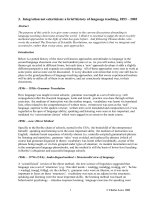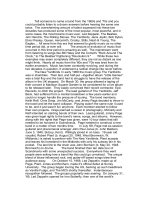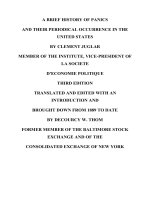A Brief History of Stock Market_8 potx
Bạn đang xem bản rút gọn của tài liệu. Xem và tải ngay bản đầy đủ của tài liệu tại đây (209.27 KB, 15 trang )
Siegel, Jeremy J. Stocks for the Long Run: The Definitive Guide to Financial Market
Returns and Long-Term Investment Strategies, 3rd ed. New York: McGraw-Hill,
2002.
Sobel, Robert. A History of the New York Stock Exchange, 1935–1975. New York:
Weybright and Talley, 1975
———. The Big Board: A History of the New York Stock Market. New York: Free
Press, 1965.
———. The Great Bull Market: Wall Street in the 1920s. New York: WW Norton,
1968.
Teweles, Richard J., and Edward S. Bradley. The Stock Market, 5th ed. New York:
John Wiley, 1987
Western, David L. Booms, Bubbles and Busts in US Stock Markets. London: Rout-
ledge, 2004.
Wigmore, Barry A. The Crash and Its Aftermath: A History of Securities Markets in
the United States, 1929–1933. Westport, CT: Greenwood Press, 1985.
ARTICLES
Allen, Franklin, and Richard Herring. ‘‘Banking Regulation versus Securities
Market Regulation.’’ The Wharton School Financial Institutions Center,
Working paper 01–29 (2001).
Baier, Scott L., Gerald P. Dwyer, Jr., and Robert Tamura. ‘‘Does Opening a Stock
Exchange Increase Economic Growth?’’ Journal of International Money and Fi-
nance (April 2004): 311–331.
Dwyer, Gerald P., Jr., and R.W. Hafer. ‘‘Are National Stock Markets Linked?’’
Federal Reserve Bank of St. Louis Review (November/December 1988): 3–14.
Claessens, Stijn, Daniel A. Klingebiel, and Sergio L. Schmulker. ‘‘The Future of
Stock Exchanges in Emerging Economies: Evolution and Prospects.’’ Brookings-
Wharton Papers on Financial Services (2002): 167–202.
Greenspan, Alan. ‘‘The Challenge of Central Banking in a Democratic Society.’’
Remarks delivered at the Annual Dinner and Francis Boyer Lecture of the
American Enterprise Institute for Public Policy Research, Washington, D.C.,
December 5, 1996. Available at www.federalreserve.gov/boarddocs/speeches/
1996.
Greenwald, Bruce, and Jeremy Stein. ‘‘The Task Force Report: The Reasoning
behind the Recommendations.’’ Journal of Economic Perspectives 2, no. 3
(Summer 1998): 3–23.
Haddock, David D. ‘‘The Swiftness of Divine Retribution and its Tendency to
Mistake its Target: An Analysis of the Brady Report.’’ In The Stock Market:
Bubbles, Volatility, and Chaos, eds. Dwyer and Hafer, 179–195. Boston: Kluwer,
1990:.
Hall, Robert. ‘‘Struggling to Understand the Stock Market.’’ American Economic
Review 91, no. 2 (2001): 1–11.
134 Bibliography
Ho, Ron Yiu-wah, Roger Strange, and Jenifer Piesse. ‘‘The Structural and Insti-
tutional Features of the Hong Kong Stock Market: Implications for Asset Pric-
ing.’’ The Management Centre Research Papers, King’s College, London 2004.
Jorgenson, Dale W. ‘‘Information Technology and the U.S. Economy.’’ American
Economic Review 91, no. 1 (2001): 1–32.
Levine, Ross, and Sara Zervos. ‘‘Stock Markets, Banks and Economic Growth.’’
American Economic Review 88, no. 3 (1998): 537–558.
Macey, Johnathan R. ‘‘Regulation and Disaster: Some Observations in the Context
of Systemic Risk.’’ Brookings-Wharton Papers on Financial Services (1998).
Parry, Robert T. ‘‘The October ’87 Crash Ten Years Later.’’ Federal Reserve Bank
of San Francisco Economic Letter 96–332 (1997).
ONLINE RESOURCES
US Stock Exchanges (Indexes)
American Stock Exchange (AMEX), .
Dow Jones Industrial Average (DJIA), />National Association of Securities Dealers Automated Quotations (NASDAQ),
.
New York Stock Exchange (NYSE), .
Russell Index, />Wilshire Index, />Related Exchanges
Chicago Board of Trade, .
Chicago Mercantile Exchange, .
International Stock Exchanges (Indexes)
Euronext (Euronext 100), .
Frankfurt (DAX), .
Hong Kong (Hang Seng), .
London Stock Exchange (FTSE 100), .
Tokyo Stock Exchange (Nikkei 225), />Toronto (TSE), .
Financial Press
Barron’s, .
Bloomberg, .
Bibliography 135
The Economist, .
Financial Times, />Investor’s Business Daily, .
TheWall Street Journal, .
Financial Data
Hoover’s, .
Moody’s, .
Standard & Poor’s, .
Government Agencies; Professional Organizations
Association of Investment Management and Research (CFA Institute), http://
www.cfainstitute.org.
Federal Reserve System, .
Financial Accounting Standards Board, .
Futures Industry Association, .
International Swaps and Derivatives Association, .
National Association of Securities Dealers, .
Public Company Accounting Oversight Board, .
Securities and Exchange Commission, .
Securities Industry Association, .
General Information for Investors
Investorguide.com, .
Investorwords.com, .
136 Bibliography
Index
American Depository Receipts (ADRs),
75–76, 127
American Stock Exchange (AMX),
4, 18, 57, 75, 98
Archipelago, 56, 111
Asian Crisis, 32
Asymmetric information, 86, 96, 120
At-the-money call option, 82, 127
Balanced fund, 68, 127
Banking Act of 1933, 23, 89, 127
Bank run, 86, 127
Bear market, 29, 47–48, 127
Behavioral finance, 64–65
Berkshire Hathaway, 43–45, 58
Big Bang, 104
Black Friday (1870), 13
Black Monday (1929), 22
Black Monday (1987), 27, 29
Black Tuesday (1929), 22
Blue chip stock, 22, 50, 58, 108
Boesky, Ivan, 24–25
Bond fund, 69, 127
Bonds, 42, 45, 127
Brady, Nicholas F., 92
Brady Report, 93–94, 97
Broker, 39, 63, 127
Buffet, Warren, 43
Bull market, 32, 33, 49, 94, 127
Bush, George W., 95
Buttonwood Agreement, 10–11
Buy and hold, 49, 50
Call options, 81–82, 127
Capital gain, 43, 45
CATS, 109
C Corporation, 127
Chicago Board of Trade
(CBOT), 78
Chicago Board Options Exchange
(CBOE), 83
Chicago Mercantile Exchange (CME),
26, 27, 78, 93
Circuit breaker, 93–94, 128
Closed-end fund discount, 128
Closed-end fund premium, 128
Closed-end funds, 71–72, 128
Common stock, 41, 45, 46, 128;
options contracts, 82
Contagion, 86, 128
Corporate board of directors,
37, 128
Coupon payment, 42, 43
DAX, 108
Dealer, 39, 128
Deposit insurance, 86
Dilution of ownership, 40
Diversification, 48, 49, 83, 128
Diversification risk, 128
Diversified portfolio, 46, 47
Dividends, 41, 128; capital gains,
43–45; investment strategies, 52;
mutual funds, 70
Douglas, William O., 96
Dow Jones Industrial Average (DJIA),
2, 57–59; circuit breaker, 93, com-
panies in, 124–26; Crash of 1929, 19;
Crash of 1987, 24; Crash of 2000, 30;
ETF, 74
Drexel, Burnham Lambert, 89; Michael
Milken, 25
Dynamic hedging/portfolio insurance,
26, 128
Earnings, 128
EDGAR, 99
Efficient markets, 62, 128; behavioral
finance, 64
Electronic trading, 2, 109, 121
Enron, 34, 46, 82, 87, 95
Equity fund, 69, 128
Euronext, 102, 110
Exchange regulation, 128
Exchange-traded funds, 74–75, 128
Exercise price, 128; options contract,
81–83
Expectations, 62–63
Expense ratio, 71
Expiration date, 81–82
Federal Reserve Bank (System), 129;
Crash of 1929, 20–21; Crash of 1987,
24, 28, 94
Financial Accounting Standards Board
(FASB), 97
Financial intermediary, 69
Fisher, Irving, 21, 22
401K programs (403B, for public
entities), 127
Frankfurt stock exchange, 102, 107–8
FTSE, 4, 60, 112
Fundamental market analysis, 65, 129
Futures contracts, 77–78, 129. See also
Single stock futures contract; Stock
index futures contract
Global Crossing, 34
Going long, 72
Going short, 72
Gould, Jay, 13
Great Crash (1929), 21, 23
Greenspan, Alan, 26, 28. See also
Irrational exuberance
Growth stock, 44, 52, 129
Growth strategy, 52
Hall, Robert, 31
Hamilton, Alexander, 10
Hang Seng Index, 107
Harriman, Edward, 16
Hedge fund, 72–74, 129
Heinze, F. Augustus, 16
HEKx, 106
Hong Kong Exchange, 102, 105–7
Hoover, Herbert, 19
Income stock, 44
Index mutual fund, 129
Initial public offering (IPO),
38–39, 129
Insider selling/insider stock sales,
34, 129
Insider trading, 120; foreign exchanges,
87, 108; Securities and Exchange
Act, 91
In-the-money call option contract,
81, 129
Investment Advisors Act of 1940, 91, 97
Investment Company Act of 1940,
91, 97
Investment grade bond, 129
Irrational exuberance, 29; behavioral
finance, 64
138 Index
January effect, 64
Junk bond, 25
Kennedy, Joseph P., 96
Knickerbocker Trust, 16
Landis: James, 96; Judge Kennesaw
Mountain, 15
Large cap, 50–51, 129
Lender of last resort, 28, 94
Leveraged buyout, 25, 129
Levitt, Arthur, 33
Liquidity, 28, 129; private stock versus
public, 40
Listing requirement, 57
Load fund, 70, 129
London Exchange, 104–5, 112, 121
Long position, 79, 80, 81, 129
Long-Term Capital Management
(LTCM), 32, 73
Margin, 129
Margin call, 23
Margin investing, 19–20, 130
Margin requirement, 20; futures
contract, 78, 79
Market capitalization, 50, 59,
102, 130
Market crash, 130
Market specialist, 121
Market timing, 49–50
Microsoft, 4, 44, 51
Milken, Michael, 25
Mini stock index futures contracts,
79, 130
Morgan, J. P., 17, 125
Morse, Samuel F. B., 11
Mutual fund, 69–70, 130. See also
Closed-end funds; Exchange
traded funds; Open-ended mutual
funds
National Association of Securities
Dealers Automated Quotation
(NASDAQ), 3, 9, 57; NASDAQ
index, 59–60
Net asset value, 70; ETF, 74
New York Stock and Exchange
Board, 11
New York Stock Exchange (NYSE),
56–57; history, 9–35; IPO, 111;
ownership, 121; self-regulation,
85–86
Nikkei 225, 60, 103–4, 112
No-load fund, 70, 130
Notional value, 79, 130
Ohio Life Insurance and Trust
Company, 12
OneChicago, 80
Open-ended mutual funds, 70–71, 130
Option premium, 72, 80, 82, 83, 130
Options contract, 80–83, 130
Out-of-the-money option, 81, 130
Over-the-counter, 130
Panic: of 1857, 12; of 1893, 14; of
1907, 14–18
Parry, Robert T., 28
Pecora, Ferdinand, 88
Pension plan, 130
Phelan, John, 26, 27
Portfolio, 72, 75. See also Diversified
portfolio
Preferred stock, 41, 44, 130
Presidential Task Force on Market
Mechanisms, 92
Price-weighted index, 58
Private stock/private placement, 40,
56, 130
Proprietary index, 61
Public Company Accounting Oversight
Board, 96
Publicly traded stock, 40, 55–56, 130;
regulations, 90, 96, 97, 99
Put option, 81–83, 130
Qualified investor, 73
Index 139
Reagan, Ronald, 92
Return, 43, 44–45, 70, 111, 130
Risk, 45–46, 130; over time, 47–49;
portfolio, 46–47. See also
Diversification; Systemic risk
Roosevelt: Franklin, 88; Theodore, 14
Russell index, 60, 74
Russian collapse, 32
Sarbanes-Oxley Act of 2002, 95–96
Schwab, Charles, 29
S Corporation, 56, 130
Secondary market transaction, 39, 131
Secondary offering, 39–40, 131
Securities Act of 1933, 90
Securities and Exchange Act of 1934,
90–91
Securities and Exchange Commission
(SEC), 96–99; oversight of NYSE, 85
Securities Investor Protection
Corporation (SIPC), 92
Securities Investors Protection Act of
1970, 92
Security, 131
Self-regulation, 88, 90, 98
September 11, 2001, 34
Share of stock, 131
Shiller, Robert, 64, 67
Short position, 79, 80, 82, 131
Siegel, Jeremy, 50, 53
Single stock futures contract, 80, 131
Small cap, 50–52, 131
SPIDER, 74
Standard and Poor 500 (S&P 500), 59.
See also Exchange-traded funds
Stock, 131
Stock derivatives, 76–77, 131
Stock exchange, 2, 131; economic
growth, 114–17; foreign exchanges
compared, 103–10
Stock fund, 131. See also Equity fund
Stockholder, 37, 131
Stock index, 3, 131. See also American
Stock Exchange (AMEX); DAX;
FTSE; HEKx; National Association
of Securities Dealers Automated
Quotation (NASDAQ); Nikkei
225; Russell index; Wilshire
index
Stock index futures contracts,
79–80, 131
Stock return, 132. See also Return
Stock ticker, 12
Super Bowl, 65
Systemic risk, 86, 132
Technical analysis, 65–66, 132
Tokyo Exchange, 102, 103–4
Tontine Coffee House, 11
Toronto Exchange, 108–10
Transparency, 99, 108
Value investment strategy, 52
Value stock, 132
Wall Street, 10, 12
Wal-Mart, 4, 31, 50, 59
Warburg, Paul, 21
Wealth, 2, 132; stock crashes, 28, 33,
48, 119
Wilshire index, 60
Wilson, Woodrow, 17
140 Index
ABOUT THE AUTHORS
RIK W. HAFER is Professor and Chairman in the Department of Eco-
nomics and Finance, and Director of the Office of Economic Education and
Business Research, Southern Illinois University, Edwardsville. He served as
Research Officer with the Federal Reserve Bank of St. Louis and his articles
on monetary policy and financial markets have appeared in such publications
as the Wall Street Journal, International Economic Journal, Economic Review,
and the Journal of Business. He is the author or editor of several books,
including The Stock Market: Bubbles, Volatility, and Chaos, How Open Is the
U.S. Economy?, and The Federal Reserve System (Greenwood, 2005).
SCOTT E. HEIN is Briscoe Chair of Bank Management and Finance at
Texas Tech University, where he teaches courses in the management of
financial institutions, multinational financial management, money and ca-
pital markets, and the U.S. financial system. He also serves as Visiting Scholar
at the Federal Reserve Bank of Atlanta and Chief Economist at Islay Op-
portunity Fund. He has published many articles in such publications as the
Journal of Financial Research, Applied Financial Economics, and the Journal of
Banking and Finance, and is on the board of editors for the Quarterly Journal
of Business and Economics.
Recent Titles in
Greenwood Guides to Business and Economics
The National Economy
Bradley A. Hansen
The Corporation
Wesley B. Truitt
Income and Wealth
Alan Reynolds
Money
Mark F. Dobeck and Euel Elliott









